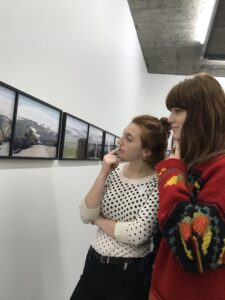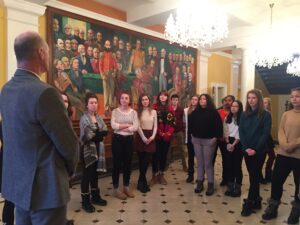

Our Tuesday morning started off with a little uncertainty due to poor weather conditions, but thankfully our entire trip is about adaptability.
Most students started off the day finishing up Njal’s Saga, a thirteenth century saga depicting the lives of earlier Icelanders. Though our initial plan was an excursion elaborating on Iceland’s early governing systems, we instead learned about Iceland’s modern governing practices.
The afternoon started with a trip to Parliament. What struck me about this experience was how subtly integrated the parliament building was among the urban landscape- I initially passed the building not knowing what it was. Upon entering, we were greeted with minimal security, which surprised us as American students who expected a long, strenuous security process. I believe this translates to how open the building was structurally and experientially. Our guide welcomed us and showed us the main parts of the building which appeared almost house-like instead of a government building. Later we discussed how the open nature of the building reflected Iceland’s Consensual Democracy- as if the building’s architecture itself was a compromise between government officials and the people. The space welcomed all who entered. After visiting parliament I noticed some connections to what I’ve read in Njal’s Saga with the idea of a collective consensus and a true notion of democracy. The Althing functioned as a very public act of governance, and I feel that this is echoed in the modern Icelandic parliament in the way it welcomed us as visitors into its space.
Late that afternoon we walked over to the Reykjavik Art Museum for a much anticipated exhibition from Olafur Eliasson. Over the course of 20 years, Eliasson photographed the changing glaciers of Iceland, and the result was the devastating effects of climate change. As we surveyed the receding glaciers, some of us noted that this time period (from 1999-2019) reflected our own ages. Over the course of our own short lives, we have seen this significant impact on climate change. What will happen when this has been over the course of forty years? Fifty years? What in our lifetimes will we endure? I believe this artwork provided an important commentary on our social value of nature. I think, at Gustavus, we are trying to make these connections between art and science as a way to provide a new perspective and continued social impact.
That evening, the group was treated to dinner. My particular group visited a Thai restaurant and enjoyed a lovely dinner and conversation.
After the group parted ways, my friends and I explored the beautifully snowy city. I so look forward to new discoveries and adventures while learning more about the functionings of Icelandic society.
Leave a Reply
You must be logged in to post a comment.